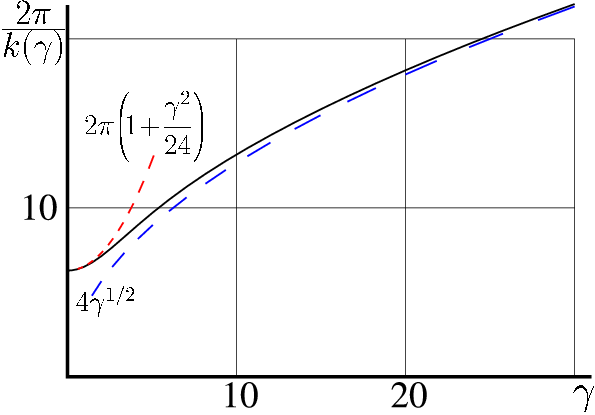- Oscillator Toda
Oscillator Toda is special kind of
nonlinear oscillator ; it is vulgarization of theToda field theory , which refers to a continuous limit ofToda's chain , of chain of particles, with exponential potential of interaction between neighbors cite journal| author=M.Toda|title=Studies of a non-linear lattice|journal=Physics Reports |volume=18|pages=1|year=1975|doi=10.1016/0370-1573(75)90018-6] . The oscillator Toda is used as simple model to understand the phenomenon ofself-pulsation , which is quasi-periodic pulsation of the output intensity of asolid-state laser s in thetransient regime .Definition
Oscillator Toda is a
dynamical system of any origin, which can be described with dependent coordinate x~ and independent coordinate z~, characterized in that theevolution along independent coordinate z~ can be approximated with equation: frac m d^{2x} m d}z^{2+D(x)frac m d}x} m d}z}+Phi'(x) =0,where D(x)=u e^{x}+v~,Phi(x)=e^x-x-1~and prime denotes the derivative.Physical meaning
The independent coordinate z~ has sense of
time . Indeed, it may be proportional to time t~ with some relation like z=t/t_0~, where t_0~ is constant.The
derivative dot x=frac m d}x} m d}z} may have sense ofvelocity of particle with coordinate x~; then ddot x=frac m d}^2x} m d}z^2}~ can be interpreted asacceleration ; and the mass of such a particle is equal to unity.The dissipative function D~ may have sense of coefficient of the speed-proportional
friction . Usually, both parameters u~ and v~ are supposed to be positive; then this speed-proportional friction coefficient grows exponentially at large positive values of coordinate x~.The potential Phi(x)=e^x-x-1~ is fixed function, which also shows
exponential grow at large positive values of coordinate x~.In the application in
laser physics , x~ may have sense oflogarithm of number of photons in thelaser cavity , related to its steady-state value. Then, theoutput power of such laser is proportional to exp(x)~ and may show pulsation atoscillation of x~.Both analogies, with a unity mass particle and logarithm of number of photons are useful in the analysis of behavior of oscillator Toda.
Energy
Rigorously, the oscillation is periodic only at u=v=0~. Indeed in realization of oscillator Toda as self-pulsing laser,these parameters may have values of order of 10^{-4}~; during several pulses, the amplutude of pulsation does not change much. In this case, we can speak about period of pulsation, function x=x(t)~ is almost periodic.
In the case u=v=0~, the energy of oscillator E=frac 12 left(frac m d}x} m d}z} ight)^{2}+Phi(x)~ does not depend on z~, and can be treated as constant of motion. Then, during one period of pulsation, the relation between x~ and z~ can be expressed analyticallycite journal|url=http://worldcat.org/issn/0722-3277| author=G.L.Oppo|coauthors=A.Politi|title=Toda potential in laser equations|journal=
Zeitschrift fur Physik B|volume=59|pages=111–115| year=1985|doi=10.1007/BF01325388] ,cite journal|url=http://www.iop.org/EJ/abstract/-search=15823442.1/1751-8121/40/9/016| author=D.Kouznetsov|coauthors=J.-F.Bisson, J.Li, K.Ueda|title=Self-pulsing laser as oscillator Toda: Approximation through elementary functions|journal=Journal of Physics A |volume=40|pages=1–18| year=2007|doi=10.1088/1751-8113/40/9/016] ::z=pmint_{x}^{x_{max!!frac m d}a}{sqrt{2}sqrt{E-Phi(a)
weherex_{min}~ and x_{max}~ are minimal and maximal values of x~; this solution is written for the case when dot x(0)=0.
however, other solutions may be obtained using the
translational invariance .
right|300px|thumb|Fig.2. Period ">T(gamma)=2pi/k(gamma)~ of oscillation versus gamma~(solid) and two its asymptiotics (dashed).The ratio x_{max}/x_{max}=2gamma~ is convenient parameter to characterize the amplitude of pulsation,then, the median valuedelta=frac{x_max -x_min}{1}can be expressed asdelta=lnfrac{sin(gamma)}{gamma};and the energyE=E(gamma)=frac{gamma}{ anh(gamma)}+lnfrac{sinh gamma}{gamma}-1also is elementary function of gamma~.For the case gamma=5~, an example of pulsation of the oscillator toda is shown in Fig.1.In application, the quantity E have no need to be physical energy of the system; in these cases, this dimension-less quantity may be called
quasienergy .Period of pulsation
The period of pulsation is increasing function of the amplitude gamma~.
At gamma ll 1~, the period T(gamma)=2pileft( 1 + frac{gamma^2} {24} + O(gamma^4) ight)~
At gamma gg 1~, the period T(gamma)=4gamma^{1/2}left(1+O(1/gamma) ight) ~
In the whole rangegamma > 0~, the period T=T(gamma)~ and the frequency k(gamma)=frac{2pi}{T(gamma)}~ can be approximated with
k_{ m fit}(gamma)=frac{2pi}{T_{ m fit}(gamma)}=left(frac{10630+ 674gamma + 695.2419gamma^2 + 191.4489gamma^3 + 16.86221gamma^4 + 4.082607gamma^5 + gamma^6}{10630 + 674gamma + 2467gamma^2 + 303.2428 gamma^3+164.6842gamma^4 + 36.6434gamma^5 + 3.9596gamma^6 +0.8983gamma^7 +frac{16}{pi^4} gamma^8} ight)^{1/4}with at least 8
significant figure s;The relative error of this approximation does not exceed 22 imes 10^{-9} .Decay of pulsation
At small (but still positive) values of u~ and v~, the pulsation decays slowly, and this decay can be described analytically. In the first approximation parameters u~ and v~ hive additive contribution to the decay; the decay rate, as well as the amplitude and phase of the nonlinear oscillation can be approximated with elementary functions in the similar manner, as the period above. This allows to approximate the solution of the initial equation; and the error of such approximation is small compared to the difference between behavior of the idealized oscillator Toda and behavior of the experimental realization of oscillator Toda as
self-pulsing laser at theoptical bench , although, qualitatively, aself-pulsing laser shows very similar behavior.cite journal|url=http://www.iop.org/EJ/abstract/-search=15823442.1/1751-8121/40/9/016| author=D.Kouznetsov|coauthors=J.-F.Bisson, J.Li, K.Ueda|title=Self-pulsing laser as oscillator Toda: Approximation through elementary functions|journal=Journal of Physics A |volume=40|pages=1–18| year=2007|doi=10.1088/1751-8113/40/9/016]References
Wikimedia Foundation. 2010.

